Content for TS 36.305 Word version: 18.0.0
7 General E-UTRAN UE Positioning procedures
7.1 General LPP procedures for UE Positioning
7.1.1 LPP Procedures
7.1.2 Positioning procedures
7.1.2.1 Capability transfer
7.1.2.2 Assistance data transfer
7.1.2.3 Location information transfer
7.1.2.4 Multiple transactions
7.1.2.5 Sequence of Procedures
7.1.2.6 Error handling
7.1.2.7 Abort
...
...
7 General E-UTRAN UE Positioning procedures p. 29
7.1 General LPP procedures for UE Positioning p. 29
7.1.1 LPP Procedures p. 29
Positioning procedures in the E-UTRAN are modelled as transactions of the LPP protocol using the procedures defined in this specification. A procedure consists of a single operation of one of the following types:
- Exchange of positioning capabilities;
- Transfer of assistance data;
- Transfer of location information (positioning measurements and/or position estimate);
- Error handling;
- Abort.
7.1.2 Positioning procedures p. 30
7.1.2.1 Capability transfer p. 30
A UE request for capability from E-SMLC or delivery of the E-SMLC capability to the UE is not supported in this version of the specification.
Capabilities in an LPP context refer to the ability of a target or server to support different position methods defined for LPP, different aspects of a particular position method (e.g. different types of assistance data for A-GNSS) and common features not specific to only one position method (e.g. ability to handle multiple LPP transactions). These capabilities are defined within the LPP protocol and transferred between the target and the server using LPP transport.
The exchange of capabilities between a target and a server may be initiated by a request or sent as "unsolicited" information. If a request is used, the server sends an LPP Request Capabilities message to the target device with a request for capability information. The target sends an LPP Provide Capabilities message.
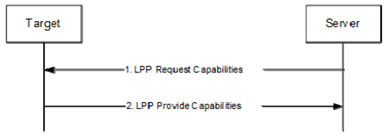
LPP Capability Indication procedure is used for unsolicited capability transfer.
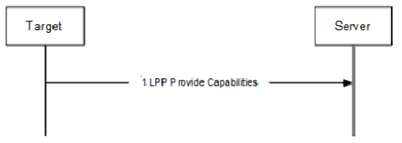
7.1.2.2 Assistance data transfer p. 31
Assistance data may be transferred either by request or unsolicited. In this version of the specification, assistance data delivery is supported only via unicast transport from server to target.
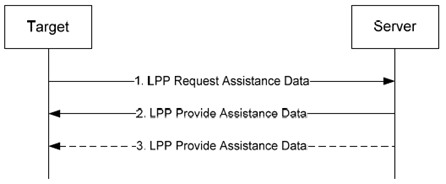
Step 1.
LPP Assistance Data Delivery procedure is used for unilateral assistance data transfer.
The target may send a request to the server for assistance data and may indicate the particular assistance data needed.
Step 2.
The server transfers assistance data to the target. The transferred assistance data should match any assistance data requested in step 1.
Step 3.
Optionally, the server may transfer additional assistance data to the target in one or more additional LPP messages.
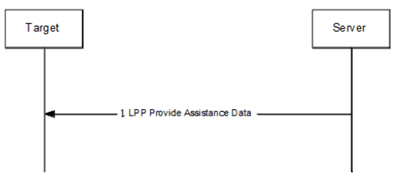
This procedure is unidirectional; assistance data are always delivered from the server to the target.
7.1.2.3 Location information transfer p. 31
The term "location information" applies both to an actual position estimate and to values used in computing position (e.g., radio measurements or positioning measurements). It is delivered either in response to a request or unsolicited.
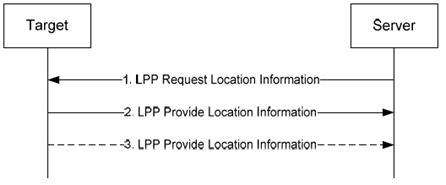
Step 1.
LPP Location Information Delivery procedure is used for unilateral location information transfer.
The server may send a request for location information to the target, and may indicate the type of location information needed and associated QoS.
Step 2.
In response to step 1, the target transfers location information to the server. The location information transferred should match the location information requested in step 1.
Step 3.
Optionally (e.g., if requested in step 1), the target in step 2 may transfer additional location information to the server in one or more additional LPP messages.

7.1.2.4 Multiple transactions p. 32
Multiple LPP transactions may be in progress simultaneously between the same target and server nodes, to improve flexibility and efficiency. However, no more than one LPP procedure between a particular pair of target and server nodes to obtain location information shall be in progress at any time for the same position method.
In this example, the objective is to request location measurements from the target, and the server does not provide assistance data in advance, leaving the target to request any needed assistance data. A message flow is shown in Figure 7.1.2.4-1.
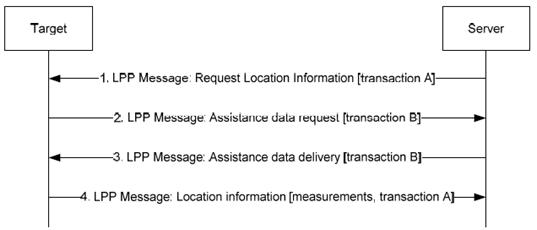
Step 1.
The server sends a request to the target for positioning measurements.
Step 2.
The target sends a request for particular assistance data.
Step 3.
The server returns the assistance data requested in step 2.
Step 4.
The target obtains and returns the location information (e.g., positioning method measurements) requested in step 1.
7.1.2.5 Sequence of Procedures p. 33
LPP procedures are not required to occur in any fixed order, in order to provide greater flexibility in positioning. Thus, a UE may request assistance data at any time in order to comply with a previous request for location measurements from the E-SMLC; an E-SMLC may instigate more than one request for location information (e.g., measurements or a location estimate) in case location results from a previous request were not adequate for the requested QoS; and the target device may transfer capability information to the server at any time if not already performed.
Despite the flexibility allowed by LPP, it is expected that procedures will normally occur in the following order:
- Capability Transfer;
- Assistance Data Transfer;
- Location Information Transfer (measurements and/or location estimate).
7.1.2.6 Error handling p. 33
The procedure is used to notify the sending endpoint by the receiving endpoint that the receiving LPP message is erroneous or unexpected. This procedure is bidirectional at the LPP level; either the target or the server may take the role of either endpoint in Figure 7.1.2.6-1.

Step 1.
The target or server (indicated as "Target/Server" in Figure 7.1.2.6-1) sends a LPP message to the other endpoint (indicated as "Server/Target").
Step 2.
If the server or target ("Server/Target") detects that the receiving LPP message is erroneous or unexpected, the server or target transfers error indication information to the other endpoint ("Target/Server").
7.1.2.7 Abort p. 34
The procedure is used to notify the other endpoint by one endpoint to abort an ongoing procedure between the two endpoints. This procedure is bidirectional at the LPP level; either the target or the server may take the role of either endpoint in Figure 7.1.2.7-1.

Step 1.
A LPP procedure is ongoing between target and server.
Step 2.
If the server or target ("Server/Target") determines that the procedure must be aborted, and then the server or target sends an LPP Abort message to the other endpoint ("Target/Server") carrying the transaction ID for the procedure.